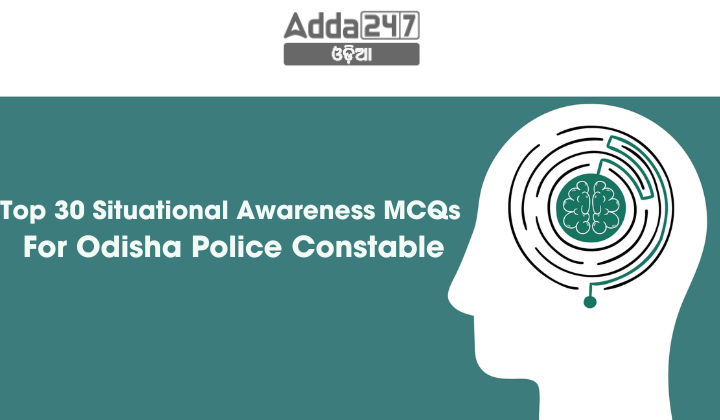Situational Awareness refers to the ability to understand, assess, and respond to situations appropriately, especially in stressful or high-stakes environments. For Odisha Police Constables, situational awareness is a key skill to handle emergencies, respond to crimes, and ensure public safety. Here are the top 30 multiple-choice questions (MCQs) that could help candidates prepare for the Odisha Police Constable exam, focusing on situational awareness and decision-making.
Top 15 Situational Awareness MCQs For Odisha Police Constable
Q1. After a purchase, the shopkeeper returns ₹ 100 extra to you. You will
(a) Treat your friends to a lunch
(b) Offer ₹ 20 at a temple and pray for more such instance
(c) Hope he will give another ₹ 100 extra
(d) Return the extra money to the shopkeeper
S1. Ans:- (d)
Sol: After a purchase, the shopkeeper returns ₹ 100 extra to you. You will Return the extra money to the shopkeeper
Q2. Your maid has invited you to her daughter’s wedding, you would
(a) Completely ignore her
(b) Attend the wedding
(c) Buy a gift for her daughter and help in the wedding
(d) Congratulate her and make up some excuse for not being able to attend
S2. Ans:-(c)
Sol: Your maid has invited you to her daughter’s wedding, you would Buy a gift for her daughter and help in the wedding
Q3. You are a member of the sports team of your college. One day, due to a misunderstanding, other members stop talking to you. You
(a) Ask someone to mediate
(b) Wait till they come and start talking again
(c) Keep to yourself and let things take their time for improving
(d) Go forward and start talking
S3. Ans:- (d)
Sol: You are a member of the sports team of your college. One day, due to a misunderstanding, other members stop talking to you. You Go forward and start talking
Q4. You are driving your car on the road when you hit against a fruit vendor’s cart. You would
(a) Escape from the site by driving away
(b) Abuse the fruit vendor for putting his cart on the way
(c) Pay the fruit vendor for the damage done to him
(d) Insist that it was not your fault
S4. Ans:- (c)
Sol: You are driving your car on the road when you hit against a fruit vendor’s cart. You would Pay the fruit vendor for the damage done to him
Q5. Your colleague is not performing his duties up to the mark. You will
(a) Just do your part of the duties and enjoy your work
(b) Take advantage of it to promote yourself
(c) Report to the seniors
(d) Try and handle his customers to maintain the company’s status
S5. Ans:- (d)
Sol: Your colleague is not performing his duties up to the mark. You will Try and handle his customers to maintain the company’s status
Q6. You are getting late for your college final term exam and the bus is not available. In such a situation you will
(a) Not give your exam and return home
(b) Wait patiently for the bus though you are late for the exam
(c) Take a cab or an auto to reach your college
(d) Start walking
S6. Ans:- (c)
Sol: You are getting late for your college final term exam and the bus is not available. In such a situation you will Take a cab or an auto to reach your college
Q7. Ram was appointed as the Captain of the football team, but other players were against his appointment. He
(a) Will try to convince them and play the match
(b) Will start fighting with his teammates who are against him
(c) Will play so well, that his teammates will start respecting him
(d) Will give up his captaincy
S7. Ans:- (c)
Sol: Ram was appointed as the Captain of the football team, but other players were against his appointment. He Will play so well, that his teammates will start respecting him
Q8. You and your friends are by the beach and are planning on doing some water sports. However, neither of you knows how to swim and there is only one safety jacket. You will
(a) Neither of you will wear the safety jacket and will do the water sports
(b) Wait for the next turn and will give the jacket to your friend
(c) Go with your friend but not wear the safety jacket and offer it to him
(d) Ask your friend not to go for swimming
S8. Ans:- (b)
Sol: You and your friends are by the beach and are planning on doing some water sports. However, neither of you knows how to swim and there is only one safety jacket. You will Wait for the next turn and will give the jacket to your friend
Q9. You have made a dinner reservation for 8 PM with your family. Your mother is always late when getting ready and is never on time. You will
(a) Tell her that the dinner reservation is for 8 PM
(b) Tell her that the dinner reservation is for 7 PM
(c) Tell her to be ready before 8 PM
(d) Tell her to be ready at 8 PM
S9. Ans:- (b)
Sol: You have made a dinner reservation for 8 PM with your family. Your mother is always late when getting ready and is never on time. You will Tell her that the dinner reservation is for 7 PM
Q10. You are in the lift and your floor has arrived, but the lift door does not open. There is no network on the phone to call anyone. You have pressed the help button in the lift.
(a) Search for a network on your phone to call for help
(b) Panic and start shouting
(c) Calm down and wait for help to arrive
(d) Try to open the door
S10. Ans:- (c)
Sol: You are in the lift and your floor has arrived, but the lift door does not open. There is no network on the phone to call anyone. You have pressed the help button in the lift.
Q11. All the hard work done by you at your workplace is hijacked by one of your colleagues, who is a good friend of yours. You will
(a) Start praising your work yourself
(b) Leave the job
(c) Criticise him in front of other colleagues
(d) Continue hard work as hard work always pays
S11. Ans:- (d)
Sol: All the hard work done by you at your workplace is hijacked by one of your colleagues, who is a good friend of yours. You will Continue hard work as hard work always pays
Q12. You are in a bus. The bus reaches your stop but you have not purchased the ticket due to heavy rush. What will you do?
(a) Jump out quickly to avoid embarrassment
(b) Call the conductor, give him the money, and get the ticket
(c) Hand the money to someone sitting nearby to give it to the conductor
(d) Give the money to the driver
S12. Ans:- (b)
Sol: You are in a bus. The bus reaches your stop but you have not purchased the ticket due to heavy rush. Call the conductor, give him the money, and get the ticket
Q13. While travelling in a train, you observe some college students pulling the alarm chain simply to get down at their desired point. You would
(a) With the help of some passengers, check them from doing so
(b) Let them pull the chain but check them from detraining
(c) Inform the guard of the train as soon as it stops
(d) Keep quiet and do nothing
S13. Ans:- (a)
Sol: While travelling in a train, you observe some college students pulling the alarm chain simply to get down at their desired point. You would With the help of some passengers, check them from doing so
Q14. Your friend has lost his/her purse with your important documents in it. You would
(a) Feel angry but do not react as anyone can make mistakes
(b) Feel angry and ask him/her to replace/duplicate the documents
(c) Understand the situation and tell him/her that it’s ok and not to worry about it
(d) Blame him/her for being careless and stop talking to him/her
S14. Ans:- (a)
Sol: Your friend has lost his/her purse with your important documents in it. You would Feel angry but do not react as anyone can make mistakes
Q15. After your graduation, you are offered a well-paid government job. However, your friend says that you have to pay a bribe to get the appointment order. You
(a) Go to some influential politician who can help
(b) Accept the job by paying the bribe, consoling yourself that this is the present social setup
(c) Accept the job by paying the bribe but firmly resolve that this is the last time you will pay bribe
(d) Flatly refuse the offer
S15. Ans:- (d)
Sol: After your graduation, you are offered a well-paid government job. However, your friend says that you have to pay a bribe to get the appointment order. You Flatly refuse the offer










